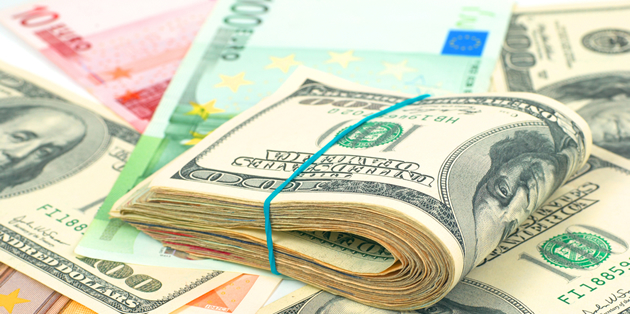Positive post-referendum data has continued to boost Pound exchange rates this week, with GBP trending higher against both the EUR and USD as Brexit worries diminish for the time being.
The Pound Euro exchange rate climbed beyond 1.1700 while the Pound US Dollar exchange rate was comfortably above 1.3200 ahead of the potentially influential Jackson Hole event.
- Bullish UK data saw Pound making further gains against rivals – GBP exchange rates benefitted from better-than-expected home loans figure
- Euro weighed down by signs of slowness in the German economy – Weak investment raised concerns over heath of the Eurozone’s powerhouse
- Confidence in the US Dollar began to soften ahead of Yellen speech – Investors await further guidance on Fed’s monetary policy outlook
- GBP USD exchange rate predicted to weaken on stronger US housing data – Positive US ecostats expected to encourage renewed demand for ‘Greenback’
Market hesitance to price in higher odds of an imminent Federal Reserve interest rate hike has kept the US Dollar on a weaker footing, with volatility expected for the GBP USD exchange rate over the coming days.
The Pound Euro exchange rate achieved a high of 1.1762 after rallying over 0.7% while the Pound US Dollar exchange rate climbed 0.4% to breach the 1.3250 level.
This is a significant turnaround from last week when the Pound hit a fresh three-year low against the Euro prior to the publication of better-than-forecast UK retail sales data.
Stronger-than-Expected UK Mortgage Approvals Shored up Pound Sterling (GBP)
Investors continued to pile back into the Pound (GBP) in the early week, reacting with relief to the better-than-expected CBI Total Orders Trend result. Clocking in at -5 rather than -10, this suggested that the negative impact of the referendum had been more muted than feared, particularly as export orders rose to a two-year high in August. Altogether this boosted confidence in the resilience of the UK economy, despite persistent uncertainty relating to the country’s exit from the EU. There was also encouragement as the Bank of England (BoE) held another successful reverse auction for long-dated government bonds.
The appeal of Sterling was boosted further by July’s BBA Loans for House Purchase figure, which failed to weaken quite as far as forecast. Mortgage approvals nevertheless weakened in the month following the referendum, with the timeliness of the data muted thanks to the longer-term nature of loan agreements. Even so, GBP exchange rates continued to trend higher, with markets remaining confident that the post-Brexit data releases are pointing towards a more stable economic outlook.
Weaker German PMIs and Investment Boosted GBP EUR Exchange Rate
It was something of a mixed day for the Euro (EUR) on Tuesday, with the latest domestic data from the Eurozone failing to offer a strongly reassuring picture. There were signs of strength from the French economy, with the August Services PMI leaping from 50.5 to 52.0. This suggested that the country was continuing to recover in spite of recent uncertainty, although the impact of the result was somewhat muted by disappointment from the corresponding German data. While the Eurozone’s powerhouse economy remained in a state of growth it nevertheless demonstrated a weakening on the month; a fresh indication that its strength is faltering.
Confidence in the single currency improved on Wednesday morning, however, as second quarter German exports were revealed to have been higher than forecast. Investors had anticipated a slowing from 1.6% to 0.7%, being pleasantly surprised when the measure instead came in at 1.2%. Although the Pound to Euro (GBP EUR) exchange rate weakened in response the news was not universally positive for the German economy, as Carsten Brzeski, Chief Economist at ING, noted:
‘The economy’s Achilles’ heel, however, remains the lack of new investment. To kick-start investment in an ageing economy, some government support is needed. Not only at the national level but also at the European level.’
US Dollar (USD) on Softer Footing as Markets Anticipated Yellen Speech
Demand for the US Dollar (USD) has remained volatile this week, with investors taking a more cautious view ahead of Fed Chair Janet Yellen’s commentary at the Jackson Hole Symposium on Friday. Hopes that the Federal Reserve could imminently return to its monetary tightening cycle were dented by fresh signs of weakness within the US manufacturing sector, as both the Philadelphia Fed Manufacturing Index and the Markit Manufacturing PMI fell short of forecast. With the world’s largest economy failing to show consistent robustness there was little reason for markets to favour the ‘Greenback’, particularly as the Fed has previously disappointed expectations of an interest rate rise.
This afternoon’s domestic housing market data could offer some support to the US Dollar, assuming that the results point towards positive conditions. A stronger property market would suggest that the US economy is not slowing so much as some fear, although even a robust showing here is unlikely to substantially impact the outlook of the Fed. Even so, if the results prove encouraging the Pound to US Dollar (GBP USD) exchange rate is expected to return to a downtrend.
Current GBP, EUR, USD Exchange Rates
At the time of writing, the Pound to Euro (GBP EUR) exchange rate was trending higher around 1.1704, while the Pound to US Dollar (GBP USD) pairing was on an uptrend in the region of 1.3225.



